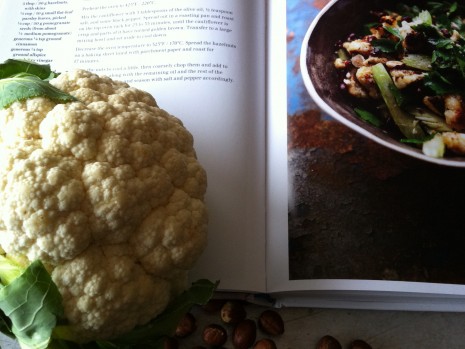O JERUSALEM: ROASTED CAULIFLOWER AND HAZELNUT SALAD
The year, 2006. The city, Jerusalem. I was there to help to help a friend celebrate an important birthday; there were six of us in all, and after days filled with sightseeing, we would order a large, satisfying spread of mezes (from beets puréed with za’atar and yogurt to spiced kofta studded with pine nuts), grilled meats, and intensely flavored little stews for dinner. The food was on the rustic side—uncomplicated, pristinely fresh, and completely of the moment. Fragrant pitas, still warm from a wood-fired oven, were the most “processed” thing we ate.
A few years later, I found myself digging into a meal with the same flavors and sense of place, but I wasn’t in the Middle East. I was in Islington, at Ottolenghi, where London chefs Yotam Ottolenghi (from Jewish West Jerusalem) and Sami Tamimi (from Arab East Jerusalem) channel the spirit of their home city. In less-knowing hands, their food—which ranges from age-old preparations to inventive twists on tradition—would be a jumble, a hodgepodge, but instead it’s a mosaic that reminds me of the extraordinary Byzantine floor in the church on top of Mount Nebo, or the Roman floor uncovered in Sepphoris, in Lower Galilee, displayed at the Israel Museum.
The third Ottolenghi cookbook, Jerusalem, was published in 2012 to starry reviews. I must admit I spent far too long simply admiring it—the evocative photos are a travelogue in themselves—but one day late last summer, I picked it up and started to cook from its pages. Charred okra with tomato, garlic, and preserved lemon, kohlrabi salad, chard fritters, and, oh, how wonderful, and familiar—puréed beets with za’atar and yogurt—lovely stuff. Now that it’s winter, I’ve turned to dishes such as chicken with caramelized onion and cardamom rice—a one-skillet wonder—butternut squash and tahini spread, and the roasted cauliflower and hazelnut salad below.
Bolstered with flatbread and hummus picked up at the corner store, it makes an absolutely terrific scratch supper. Don’t be alarmed at the list of ingredients: You do need a cauliflower, obviously, but odds are you already have celery, parsley, and the ground spices. If you don’t have sherry vinegar, run out and get some! It’s my go-to vinegar these days. And Yotam and Sami would be the first people to tell you that you should treat their recipe as more of a guideline. On various occasions, I’ve substituted almonds for the hazelnuts, dried cranberries for pomegranate seeds, or sorghum for the maple syrup. It’s always good.
Roasted Cauliflower & Hazelnut Salad
Adapted from Jerusalem: A Cookbook, by Yotam Ottolenghi and Sami Tamimi (Ten Speed Press, 2012)
1 head cauliflower (about 1½ pounds), cored and broken into small florets
Extra-virgin olive oil
Coarse salt and freshly ground pepper
1 large celery stalk, thinly sliced on an angle
5 tablespoons hazelnuts, with skins
1/3 cup small flat-leaf parsley leaves
1/3 cup pomegranate seeds (from about ½ pomegranate)
A generous ¼ teaspoon ground cinnamon
A generous ¼ teaspoon ground allspice
1 tablespoon sherry vinegar
1½ teaspoons pure maple syrup
1. Preheat the oven to 425º. Mix the cauliflower with about 3 tablespoons oil to coat and season with salt and pepper. Spread out the cauliflower on a rimmed baking sheet and roast until the cauliflower is crisp and parts have turned golden brown, a good 20 minutes or more. Transfer to a large mixing bowl and set aside to cool.
2. Decrease the oven temperature to 325º. Spread the hazelnuts on a baking sheet lined with parchment paper and roast until they smell roasty-toasty, about 17 minutes. Allow the nuts to cool a little, then coarsely chop them and add to the cauliflower, along with about 2 tablespoons oil and the remaining ingredients. Stir, taste, and season with salt and pepper accordingly. Serve at room temperature.
Posted: January 15th, 2013 under cookbooks, food, people + places, recipes.




